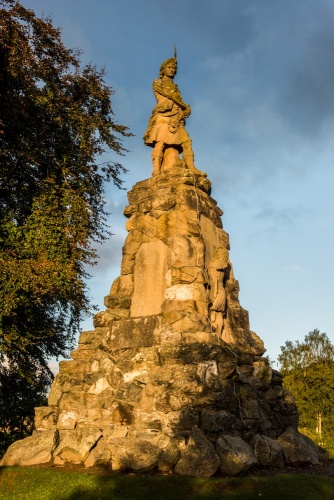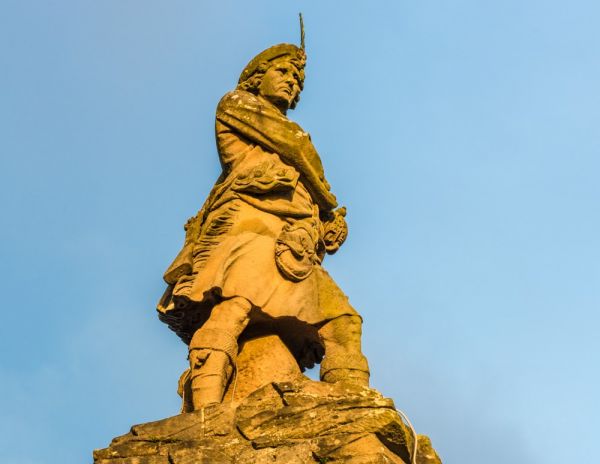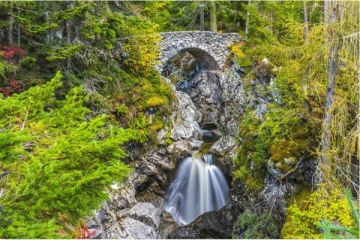
In a public park overlooking Wade's Bridge and the River Tay in Aberfeldy, Perthshire stands a striking memorial to the soldiers of the Black Watch Regiment (the Royal Highlanders). The monument is in the form of a massively tall cairn topped by a statue of a soldier wearing the original Black Watch Regimental uniform. Though the statue represents all members of the regiment, it is, in fact, a depiction of Private Farquhar Shaw.
Private Shaw was one of three men executed for desertion in 1743. That would at first glance make him an odd choice to be featured on the regimental memorial, but there is more to the story than meets the eye.
The Black Watch was ordered to march south from Scotland to London. That in itself was odd, for the regiment normally served in Scotland. When they reached London a rumour spread that they were to be transported to the American colonies, which was a method used by Parliament to disperse troublesome Highland clans.

A large number of soldiers were so alarmed that they left London, intending to march back north to Scotland. They were stopped after 2 days. The soldiers who had remained in London set sail to fight in Flanders, not to America.
Even though the 'deserters' had made their decision based on false rumours, the government could not ignore their actions. All were tried by court martial and sentenced to death. In the end, only three men were shot, among them Private Farquhar Shaw.
The cairn is inscribed with the following words:
THIS CAIRN IS ERECTED BY GRATEFUL AND ADMIRING COUNTRYMEN
IN COMMEMORATION OF THE ASSEMBLING TOGETHER AT TAYBRIDGE
IN OCTOBER 1739
OF THE SIX INDEPENDANT COMPANIES AFTERWARDS INCREASED TO TEN
OF THE "FREICEADAN DUBH" OR BLACK WATCH
WHO AFTER SERVING IN VARIOUS PARTS OF THE HIGHLANDS
WERE EMBODIED INTO A REGIMENT DESIGNATED THE 43rd AND AFTERWARDS
THE 42nd ROYAL HIGHLANDER WHOSE FIRST MUSTER TOOK PLACE IN MAY 1740 NEAR
TAYBRIDGE AND ALSO IN RECOGNITION OF THE VALOUR AND PATRIOTISM
WHICH HAVE EVER SINCE DISTINGUISHED THE SOLDIERS OF THIS CORPS DURING ITS ILLUSTRIOUS CAREER IN MANY LANDS
A.D. 1887
Note the mis-spelling of the word 'independant'.

On the north-west face of the cairn is an inscription in Gaelic commemorating the foundation of the Regiment. An English translation of the inscription reads in part:
'The lands and bens and glens and heroes. This cairn has been erected to commemorate the forming into one company at this spot of the six Highland companies called The Black Watch 1740. And from that day this regiment won many battles in different parts of the world proving their valour and patriotism of the Gael'
A plaque on the rear face of the memorial cairn commemorates the donation of the land for the monument by Gavin, Marquis of Breadalbane. Another face of the cairn has a kilted figure beneath an inscription of battles where the Black Watch served with distinction, including Waterloo, Corunna, Lucknow, Alexandria, and Havana.
The Black Watch
The origins of the Black Watch go back to 1667 when Charles II called on clan chieftains to muster independent companies of soldiers to keep the peace in the Highlands. The companies were disbanded in 1717 only to be reformed in 1725.
The new companies were recruited from Highland clans who remained loyal to the government during the 1715 Jacobite Rebellion. The origin of name 'Black Watch' is a subject of some debate, but one theory is that the black comes from the dark colour of the tartan uniforms, which contrasted with the bright red uniforms of ordinary soldiers, and the 'watch' from the fact that they were established 'to watch upon the braes' (i.e. the Highlands).

In 1739 the Highland companies were merged to form a regiment of Scottish foot soldiers. They were originally the 43rd Highland Regiment but in 1749 they became the 42nd Highland Regiment. The royal decree setting up the regiment specified that members were to be drawn only from Scotland.
The very first regimental parade was held at Aberfeldy in 1739, on a site now occupied by the local golf course. The regiment was mustered for the first time in May 1740 at Weem Cow Park, across the River Tay from Aberfeldy.
By the late Victorian period the Black Watch had gained an enviable reputation as an elite fighting force. Major James Menzies of the Glasgow Highlanders proposed a monument commemorating the first muster some 147 years before. The memorial was intended to celebrate Queen Victoria's Jubilee as well as the regiment itself.
The natural location for the monument would have been in the meadow on the west bank of the Tay where the muster took place but that site was prone to flooding. An alternate site was selected on the east bank, looking towards the meadow.
The monument was erected by public conscription and cost £500.
On 12 November 1887 the Marquis of Breadalbane unveiled the monument on the east bank of the River Tay, opposite the location of that first muster.

The regiment was represented by a detachment of 39 men commanded by Lieutenant McLeod of the Perth Depot, 1st Battalion 42nd Royal Highlanders. They were led in a procession by a pipe band from the 10th Lanark Volunteers (Glasgow Highlanders).
The ceremonial axe used to unveil the memorial is now held at the Black Watch Museum in Perth.
In 1910 the monument was struck by lightning, splitting the monument in two and causing extensive damage. It was repaired and a lightning conductor strap installed, running from the top of the memorial to a rod in the earth at its base to diminish the chance of future damage.
The Black Watch was granted the freedom of Aberfeldy in 1970.

Getting There
The Black Watch Memorial is directly beside General Wade's Bridge, erected in 1733 by General George Wade as part of the British government's attempts to improve military transportation in the Highlands in case of another Jacobite rebellion.
There is no dedicated parking but it is very easy to park along Taybridge Drive, directly beside the memorial. It is easy to access on foot from the centre of Aberfeldy and there are pedestrian fingerposts indicating the way.
About Black Watch Memorial, Aberfeldy
Address: Taybridge Drive,
Aberfeldy,
Perthshire,
Scotland, PH15 2FG
Attraction Type: Historic Building - Monument
Location: At the junction of Taybridge Drive and Taybridge Road (B846)
Website: Black Watch Memorial, Aberfeldy
Location
map
OS: NN851492
Photo Credit: David Ross and Britain Express
NEARBY HISTORIC ATTRACTIONS
Heritage Rated from 1- 5 (low to exceptional) on historic interest
General Wade's Bridge - 0 miles (Historic Building) ![]()
Aberfeldy, St Andrew's Church - 0.1 miles (Historic Church) ![]()
Aberfeldy Water Mill - 0.2 miles (Museum) ![]()
Moness Cup-Marked Stone - 0.4 miles (Prehistoric Site) ![]()
Birks of Aberfeldy - 0.4 miles (Countryside) ![]()
Old Kirk of Weem - 0.6 miles (Historic Church) ![]()
Weem Forest & St David's Well - 0.7 miles (Countryside) ![]()
Castle Menzies - 1.1 miles (Historic House) ![]()
Nearest Holiday Cottages to Black Watch Memorial, Aberfeldy:
More self catering near Black Watch Memorial, Aberfeldy



